Try one — or several — of these 17 positions for natural birth. They’ll help your body work with your baby for a safe birth!
By Kristen, Contributing Writer
I challenge you to stop for a minute and think up all of the Hollywood birth scenes you’ve seen. Now I want you to toss them all. And, while you’re at it, toss all the scenes from “reality shows” involving birth too.
The positions those moms labored and birthed in are not only useless in helping get a baby down and out, they’re sometimes harmful. Fortunately, moms like you are demanding evidence-based birthing practices. Let’s look at what positions really help baby out – safely and smoothly.
Positions are Powerful
The positions you use during your birthing time can have an incredible impact. You might not realize it, but your baby is very busy during birth. He or she is curling, tucking, rotating, spinning, flexing, and moving down. Fundamentally, everything your body does is to support what your baby is doing.
The positions you use during labor and birth help your baby do the work of moving down and out. Here are some examples of how positions help:
- Opening your pelvis to create more room for baby
- Assisting baby’s work to rotate in a particular direction
- Letting gravity help baby move down
- Removing tension that’s slowing baby down
- Re-shaping your pelvic landmarks so baby can travel over, under, or around them
- Helping you relax and rest when necessary
- Relieve intensity/pain that you’re having a hard time with
Because birthing while semi-reclined in a hospital bed is the medical paradigm pregnant women are indoctrinated to, many women don’t even realize position is a powerful, natural help during birth – but truly it is!
Standard Positions may be Dangerous
Speaking of that stereotypical medical birthing position – there’s good reason to avoid it. Positions where you’re lying on your back, or even in a semi-sitting position, are potentially dangerous to you and your baby.
The danger is both direct and indirect. Let me explain:
Directly, reclining back in bed compresses the aorta and inferior vena cava, major blood vessels in our cardiovascular system. Your doctor or midwife may have actually mentioned these to you because sometimes pregnant moms who regularly sleep or lie on their back in late pregnancy compress these vessels without realizing it.
The compression can actually lead to a cardiovascular disorder called supine hypotensive syndrome. Things are generally not going to get to that point during labor. But how many times have you heard someone say “the baby’s heart rate was dropping” or “the baby was in distress?” False positives on electronic fetal monitors are part of the problem – click here for Is Fetal Monitoring Really Saving Babies?.
But position is another huge issue. Moms stay in one place for their entire labor, sometimes unable to move or shift due to medications, other times locked in place by policies and procedures. Vessels get compressed. Baby can’t shift or get Mama to shift.
When baby’s birth draws near, women are put into unnatural positions that further compress blood vessels and put incredible tension on the pelvic floor that wouldn’t otherwise be there (we were not meant to give birth with our legs up in the air).
That leads to the indirect dangers of “standard” labor and birthing positions. They hold the pelvis and the baby in unnatural, restrictive places. A woman can’t get up and move to help her baby rotate. She can’t get up and flex to open her pelvis and make room for the baby.
Work with Your Baby (You DON’T Have to Stay in Bed)
There’s a massive misconception – that the pelvis is rigid and inflexible. This is basically true for men. Hopefully, you can see the glaring inconsistency – birthing mothers are not men. They are women, and women’s pelvises, especially pregnant pelvises, are made to move!
They’re meant to shift, flex, and open for baby. Hormones help with this, and the positions you choose and use during labor and birth help too.
When women stay in one place, landmarks on the pelvis, such as the coccyx (or tailbone) can cause baby to stop moving down. When mom moves and the pelvis flexes, baby can get past this landmark. Babies are meant to rotate, and women’s pelvises are meant to open.
When you’re birthing your baby you are not alone – your baby is right there with you. Your little partner 😉 Focus on working with your baby during his or her birth. You don’t have to stay in bed. You can change positions and help him or her move right on down.
Let’s cover some helpful positions!
Safe and Effective Positions for Natural Birth
Study these positions, then really play with them here and there throughout the rest of your pregnancy.
Which ones make you feel more “open?”
Which ones make you feel “closed?”
Which cause tension? Which are comfortable? Exploring and playing… being curious about this (even if you do it privately and ask these questions only in your own mind) really brings a good body awareness, which helps you during your birthing time.
Upright Positions
Upright positions are great at bringing your baby right down over the cervix. Gravity helps, too!
They’re very useful early in your birthing time to help things establish, and walking can help you pass the time. They can make things more intense, but if you need help getting your baby moving, the intensity is worth it. Have your coach breath and work actively with you to help you as you both help your baby.
Walking
Walking is a good way to keep things moving along well and to help you work with birthing energy. It’s especially helpful in the early stages of birthing.
Leaning on a Counter or Chair
Counters or sturdy chairs are great to lean on and put your weight into because you can ground yourself firmly while you roll and rotate your hips, or just need support during a rush. They also don’t get tired :)!
Here I’m using a chair since I could move it into the picture, but a counter works very well too! You can spread your legs to the point comfortable to you, and you may find yourself naturally squatting a little with birthing waves.
Leaning on a Support Person
You can also lean on a support person. This is a versatile position because you can stand, sway, dance a little, or you can walk (your support person would be walking backward) slowly. Since your full weight isn’t on your support person most of the time, it tends to be a sustainable position.
Stand with One Leg Up on Something
This position can help you feel very open. Experiment with different heights to see what’s comfortable – a low stool, the seat of a chair, or the side of a tub are good options. It’s best if you can use this position with a support nearby, either an object, wall, or person.
Kneeling Positions
Hands and Knees
Hands and knees is a great position that many birthing women find themselves in naturally, especially as they move deeper into their birthing times. It’s a very natural position for the second stage. If your baby’s heart rate seems to be slowing a lot, hands and knees is a beneficial position to get good blood flow to your placenta and babe.
You can use this position in bed 🙂
On Knees, Leaning Forward
You’ll use this position leaning forward into the seat of a chair, a stool, birth ball, the side of the birth tub, etc. It’s a comfortable position that lets you keep baby positioned well, and you can rise up and move as rushes come over you. It’s another you can use in bed.
I leaned forward on the edge of the bith tub for many of my baby’s births. I was kneeling in the position you see above, only slight more upright and with my legs spread open more. This is a comfortable and effective position for birthing a baby – I have birthed four of mine this way!
Kneeling with One Leg Extended
In this position, you’re kneeling on one knee, but have the other leg out to the side. This position is another that really opens the pelvis. It’s harder to stay in for long periods, but you may want to use it to really position baby well, or use it for a few minutes, kneel to rest, then go back.
Sitting Positions
Remember to use good posture when sitting – you don’t want to “tuck your pelvis under.” This will come much more naturally if you’re using this good posture during pregnancy:
- Sit down as if your chair were slightly behind you, so your tailbone is out and the top of your pelvis is tilted forward
- Hinge forward slightly at your hips rather than curling your back
Here I am simply sitting on my birth ball, demonstrating good posture for pregnancy. I’m sitting straight, but if I wanted to lean forward on something to rest, I’d “hinge” forward at my hips rather than curling my back.
You can pull your belly in slightly (or do Tupler belly exercises) for a bit! My tummy muscles are totally relaxed in this picture.
Your pelvis doesn’t need to stay stable in this position. You can feel free to rock back and forth, side-to-side, circle your pelvis around, etc. You can relax a bit, too, don’t be afraid of that.
Find a point where you feel comfortable, and be aware of how your pelvis situated. You want your tailbone back, rather than “tucked under”.
Sitting on a Birth Ball, Leaning into a Support
This is a great position to use with your birth ball because you’re able to rest nicely and still keep a good, mobile pelvis. Leaning on a chair, a bed, couch, or the arm of a piece of furniture are all good choices. Remember, you can put a towel under you on the birth ball and have it changed periodically if it’s getting damp 😉
Leaning Over the Back of a Chair
This position keeps your pelvis and baby nicely aligned, and can give you a rest if you need it. It also opens your pelvis up nicely. You’re not able to move too much in this position, though, so after your rest try and pick a more active position (such as the supported sit on a birth ball above).
Sitting on a Birth Stool
A birth stool can be great, especially as you’re getting close to pushing. Many women find it easy to relax as it’s similar to the toilet seat 🙂 There’s an opening for your baby to come through, too, so you can give birth on a birth stool 😉
Tailor Sitting or Indian Style Sitting
Very simple sitting that helps open the pelvis. Versatile and can be used on a floor, chair, or in bed! You can also sit with the balls of your feet together to get a more open pelvis.
Sitting on Someone Else’s Lap
This can be a really comforting position or a position to make you feel safer if you’ve just gotten settled in your hospital room or birth center room. You might also choose this position if things are particularly intense at any point and you need a lot of physical and emotional support.
Remember if you’re using this position, or any dependent on a support person, your support person may need a break from time to time to stretch, use the bathroom, etc . Have someone else step in, lie on your left side, or support yourself with a birth ball, counter, etc. until they return 🙂
On the Toilet
The toilet is often a good place to sit if you can’t relax because it’s pretty natural to relax your pelvic muscles on the toilet seat!
I didn’t feel the need to take a picture of the toilet – you know what it looks like!
Squatting Positions
Remember, you want to squat with your feet flat if possible, so use a support person or object to lean into. This positions your pelvis optimally for good baby position. Like with good posture, squatting during pregnancy can help you get your body used to good squatting positions. Many prenatal yoga exercises include this 🙂
Supported Squat
This squat can be done in front of a birth ball, support person, bed, couch, the side of your birthing tub, etc.
Hanging Squat
You do this by squatting slightly as you’re hanging on your partner for support. This is a good position for actually pushing your baby out.
You coach/support person may want to be leaning back against a wall to give them support.
Squat with One Leg Extended
Like the other positions with a leg extended, this one can really help open your pelvis. The kneeling variation may be more sustainable for long-term, but this one gives you a lot of flexibility in your pelvis (so you can rock it back and out of the way):
Lying Down Positions
Lying down is a good way to rest (though some moms find they can’t lie down… they just need to be up and more active). It’s also a good choice when you’re pushing a baby who wants to come very fast and you want to slow things down to stretch your tissues! Someone else can hold your leg up if you’re on your side while you’re pushing your baby out.
Lie on your left side with your belly angled down slightly, as I demonstrate in the picture:
Would you like to get all of these positions and several more in an easy handout form? Would you like more tips on keeping your labor moving smoothly and easily? Natural childbirth essentials – you’ll get printable handouts, video lessons, and more.


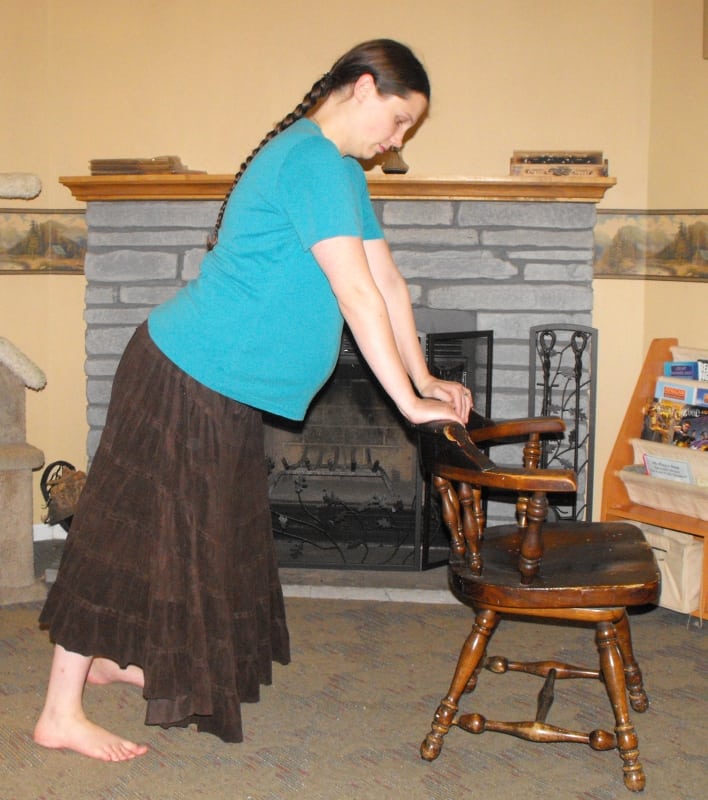
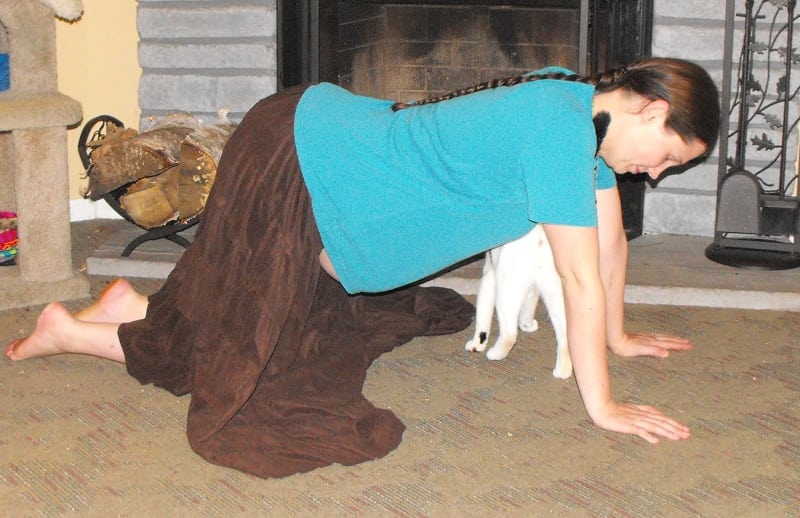
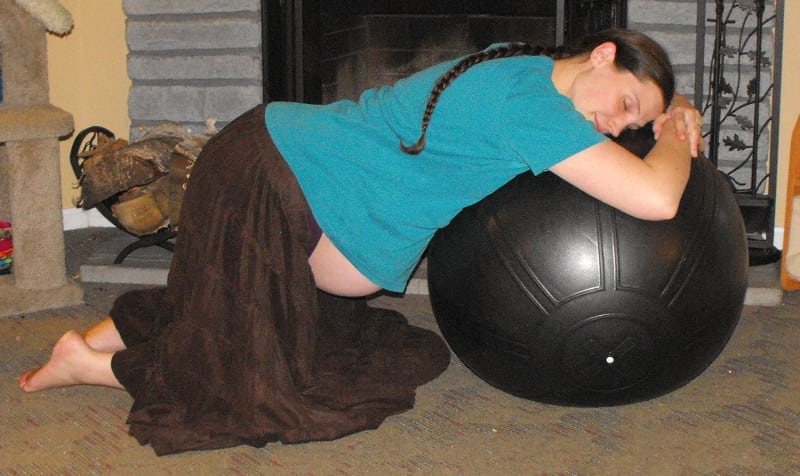
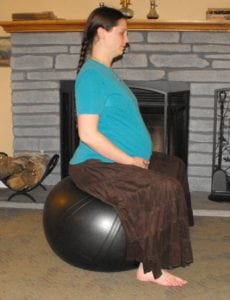
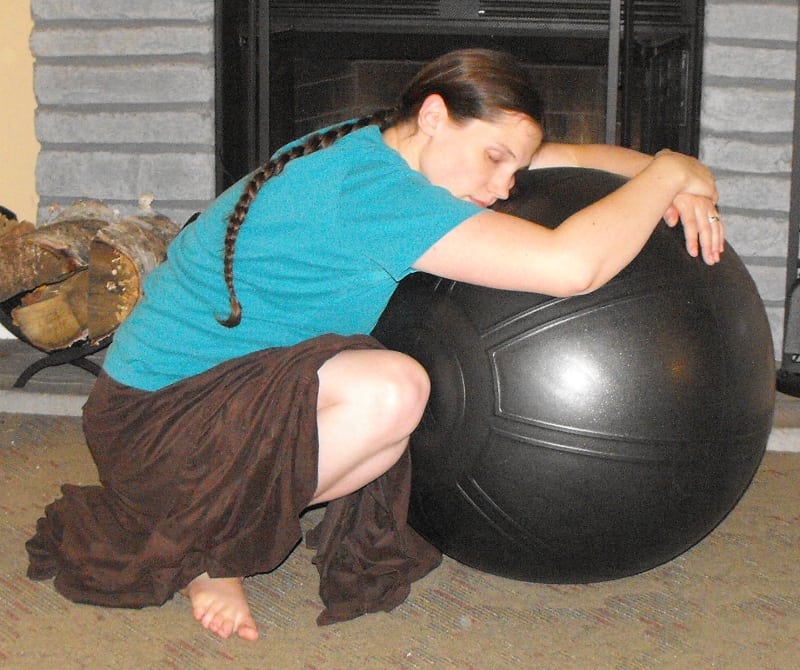

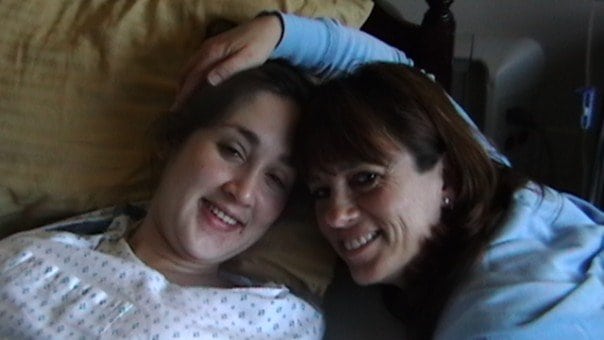


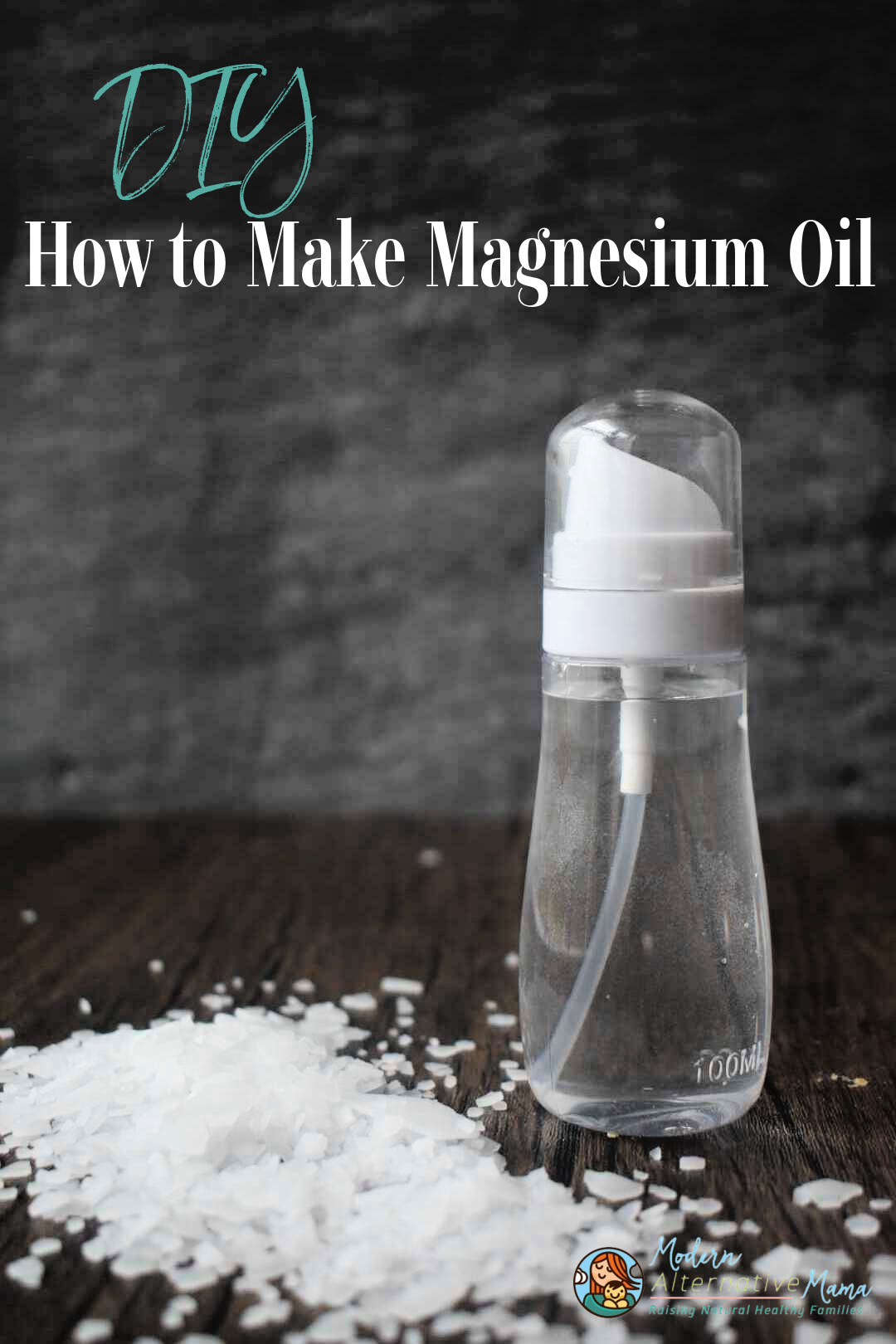

[…] way to go through labor.